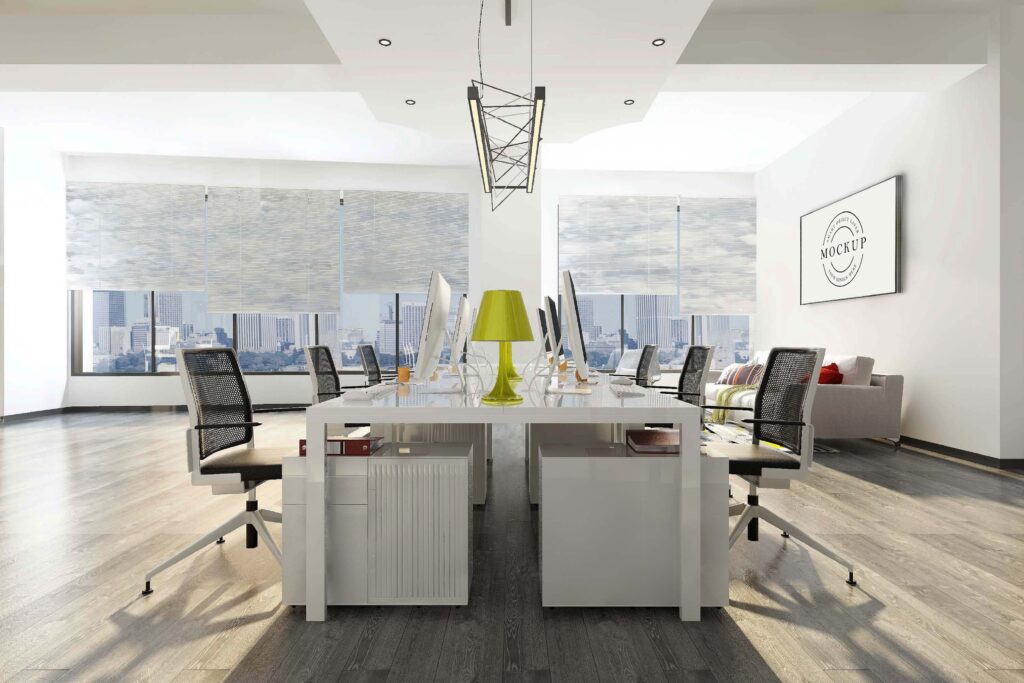Introduction
In an era defined by information overload, visual noise, and constant digital distraction, the spaces we inhabit matter more than ever. Offices are not immune to this overwhelm. From cluttered desks and bulky furniture to chaotic layouts, traditional offices often contribute to mental fatigue rather than alleviate it.
Minimalism offers a powerful counterbalance. More than a design style, it’s a mindset—about creating intentional, functional spaces with only what is necessary, so the human mind can focus, breathe, and create. At TabDesignStudio, we champion minimalist office interiors that bring structure, serenity, and sharp focus to the workplace.
1. The Psychology of Minimalism: Why Less is More
Minimalism isn’t about empty space—it’s about purposeful space. Every item in a minimalist office exists for a reason. This clarity mirrors the clarity we seek in our thoughts and tasks.
Psychological Benefits of Minimalist Workspaces:
- Reduces decision fatigue: Fewer visual stimuli means your brain can focus more deeply.
- Lowers stress: Clean, organized spaces signal safety and calm.
- Improves focus: Uncluttered surfaces help eliminate distractions.
- Boosts creativity: Empty space leaves room for imagination and new ideas.
🔹 Scientific insight: Studies show that cluttered environments increase cortisol levels and can negatively impact working memory.
2. Clean Lines & Functional Design: The Hallmarks of Minimalist Interiors
Minimalist design strips away the unnecessary—but never at the cost of utility or comfort. In fact, function is at the heart of every choice.
Core Elements We Use at TabDesignStudio:
- Streamlined furniture: Simple silhouettes with ergonomic comfort, like floating desks or slender-legged chairs.
- Neutral color palettes: Soft whites, beiges, greys, and muted tones that calm the eye and balance the space.
- Storage integration: Built-in cabinets and hidden compartments maintain visual cleanliness without reducing practicality.
- Negative space: Intentional empty zones that allow the room to breathe—visually and mentally.
🔹 Design tip: In open-plan offices, we use minimalist design to create visual flow without barriers—using low partitions, monochrome palettes, and consistent materials.
3. Space Planning for Mental Clarity
Minimalism begins with intentional space planning. Before we bring in furniture or finishes, we ask: How will this space be used? What does the user need to feel grounded and supported?
How We Plan Minimalist Layouts:
- Defined zones: Each part of the office has a distinct, necessary purpose—no overlap, no redundancy.
- Symmetry and balance: Layouts that feel psychologically harmonious, not random.
- Visual consistency: Repetition of materials and colors to create rhythm and simplicity.
- Circulation space: Clean, open walkways that promote movement without congestion.
🔹 Real-life result: In a consultancy firm we redesigned, simply shifting to a clean-lined floor plan with fewer visual blockages improved employee satisfaction scores by 42%.

4. Digital Declutter: Designing for a Paperless Future
Minimalism is also about digital behavior. Offices today need to support clean digital work environments just as much as physical ones.
How We Support Digital Minimalism:
- Integrated tech solutions: Concealed cables, wireless charging stations, and touch-screen control panels reduce surface mess.
- Hot-desking zones: Fewer permanent desks, more shared, clean spaces.
- Document management zones: Small scanning and device hubs that encourage digital filing over paper hoarding.
- Declutter stations: Smart lockers and minimal filing units encourage end-of-day resets.
🔹 Impact: A visually and digitally decluttered space improves mental clarity, especially for tech-heavy or analytical roles.
5. Aesthetics with Depth: Minimalism Doesn’t Mean Boring
One common misconception is that minimalist offices are sterile or cold. When done right, minimalism is warm, welcoming, and deeply sophisticated.
Techniques We Use to Add Depth & Texture:
- Material layering: Mixing matte with gloss, or warm wood against cool metal, for subtle contrast.
- Accent details: A single bold painting or a sculptural chair to create visual interest.
- Softness in minimalism: Plush rugs, warm lighting, and natural textures to offset clean lines.
- Biophilic accents: A few well-placed indoor plants to bring life and color without crowding the space.
🔹 TabDesignStudio approach: We balance minimalism with human emotion—creating offices that feel intentional and elevated, not clinical.
Conclusion: Minimalism as a Strategy, Not Just a Style
Minimalism is not about doing less—it’s about doing only what matters, beautifully and deliberately. It creates space for people to think, work, breathe, and connect without unnecessary interference.
At TabDesignStudio, our minimalist interiors are built to serve function and form, clarity and comfort. Whether you’re a start-up embracing agility or a large firm seeking elegance, a minimalist office is your canvas for focus, flow, and forward-thinking.

